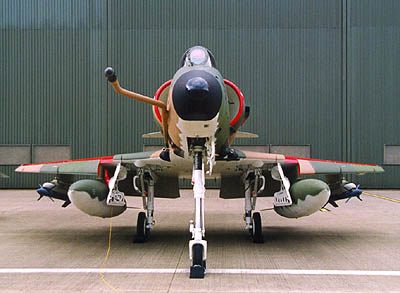A-4SU and TA-4SU Super Skyhawk
In 1985, as a result of four A-4S being written off in separate accidents, coupled with the low serviceability of the original batch of A-4S. Investigations conducted by RSAF reveal that although there was plenty of fuselage life left, the Wright J65 turbojet engines in use by the Skyhawks was too old and the associated spare parts were becoming both difficult and expensive to obtain. Consequently, the RSAF decided to upgrade the A-4S/TA-4S rather than to replace them.[4]
With SAI contracted as the main contractor for the upgrading project and a non-afterburning General Electric F404-GE-100D turbofan engine selected as the new engine, the upgrading project would later be extended to cover the entire fleet of newer A-4S-1s as well as taking the opportunity to completely modernize the avionics package (newly installed equipment now included a Pave Penny laser seeker mounted in the nose, an Inertial navigation system (INS), a Tactical air navigation system (TACAN), fore & aft Radar warning receivers (RWR) and chaff/flare countermeasures) of the aircraft.[4]
The modernized A-4SU and TA-4SU versions with its new F404 turbofan engine had 29% more thrust, which resulted in a 30% reduction in takeoff time as well as an increase in usable payload, range and maximum speed. The maximum speed now at sea level is 610 knots (1,130 km/h; 700 mph), and maximum cruise speed at 30,000 feet (9,100 m) is 446 knots (826 km/h; 513 mph).[4][5]

SGT James E. Lotz, USAF - US Defense Visual Information Center photo DF-SD-04-00140
A Republic of Singapore Air Force Douglas A-4SU Skyhawk aircraft takes off at Korat AB, Thailand for a mission in support of Exercise COPE TIGER '02 on 16 Jan 2002. Cope Tiger is an annual, multinational exercise in the Asia-Pacific region which promotes closer relations and enables air force units in the region to sharpen air combat skills and practice interoperability with US Forces. Note the empty multiple ejector rack (MER) mounted on the centerline hardpoint.
Operational history

Head on profile of an A-4SU Super Skyhawk, note the cranked refuelling probe, the drooped leading edge slats as well as the ram-air intake. Also, inert AIM-9 Sidewinders painted in blue are carried on the outboard pylons.
By 1974, the RSAF received enough refurbished A-4S to form the No. 142 Gryphon Squadron and No. 143 Phoenix Sqn, which were based at Tengah Air Base and Changi Air Base, respectively. In RSAF service, the A-4S/TA-4S were given 3-digit serials starting with 6 (e.g. 600, 651).[6][7]
From 1982 A-4S-1 and TA-4S-1 Skyhawks would join the RSAF as attrition replacements with the balance being allocated in 1984 to form a new unit - No. 145 Hornet Squadron which was also based at Tengah Air Base. These were given 3-digit serial starting with 9 (e.g. 900, 929).[6][7]
In total, approximately 150 airframes (all A-4Bs and Cs) were acquired by Singapore.[2]
The modernized A-4SU Super Skyhawks were received by 143 Squadron first, followed by 142 and 145 Squadron of the RSAF from 1989 onwards. The type was also operated by the RSAF Black Knights aerobatic display team for precision aerial manoeuvers from 1990 to 2000.[6][8][9]
https://en.wikipedia.org/wiki/ST_Aerospace_A-4SU_Super_Skyhawk
El motor que usaban los Singapurenses era el F-404-GE-1000D sin post combustión de 10.800 libras de empuje. Fuente:
https://www.militaryfactory.com/aircraft/detail.asp?aircraft_id=1624

Fuente: https://www.jetphotos.com/photo/6795570
Como comentario.
A primera vista parece mala idea seguir metiendole plata al A-4AR, habiendo necesidad urgente de cazas.
Pero luego de pensar y darle una vuelta, remotorizar no se ve tan mala idea si el A-4AR "remotorizado" pasase a ocupar labores de ENTRENAMIENTO DE IV FASE y así ahorrarte el LIFT, es decir, tendría cierta cabida si lo pensamos como medio se segunda línea y continuación del ciclo de formación de pilotos desde el Pampa.
Sería un ciclo así:
FASE I : Grob T-120P
FASE II : Texan II
FASE III: Pampa III
FASE IV: A-4AR "F-404-GE-1000D"
CAZA SUPERSÓNICO: ¿XXX?
